The "Museumstoomtram Hoorn - Medemblik" is the steam tram museum of the Netherlands. The tram is actually a train. Why tram you may ask. Well, in the Netherlands, a directive stated that any train travelling on a non-national line track was deemed to be a tram. The workshop at the end of the platform is where the restoration of historic locomotives, coaches and wagons takes place. Today we were to be transported by the most famous locomotive, "Bello", which transported beach goers to Bergen aan Zee from Alkmaar until 1955.
Constructed in 1887, the Hoorn-Medemblik line connects two proud and historic seaport cities in West Friesland. During the Dutch Golden age in the 1600s, Hoorn and Medemblik were launching pads for the deep-bottomed sailing vessels which made the Netherlands a power in trade and exploration (indeed, South America's Cape Horn honours the city of Hoorn, so named by the Dutch explorers who first reconnoitred the area). By the 1900s, however, silting in the Zuider Zee, Holland's great inland sea, had caused the overseas trade to desert both cities in favour of the North Sea port of Rotterdam. By the time the railway came to link the two towns, the area was more a rural backwater than a centre of commerce. Despite the region's reduced circumstances, the rail line did a good business for eighty years or so, ferrying fish from the two ports and fruits and grains from the nearby farms to the great urban markets at Amsterdam. However, declining traffic volumes placed the line on the closure list in the 1960s. The prospect of abandonment rallied the line's friends, and enthusiasts successfully took over operation of the railway in 1968.
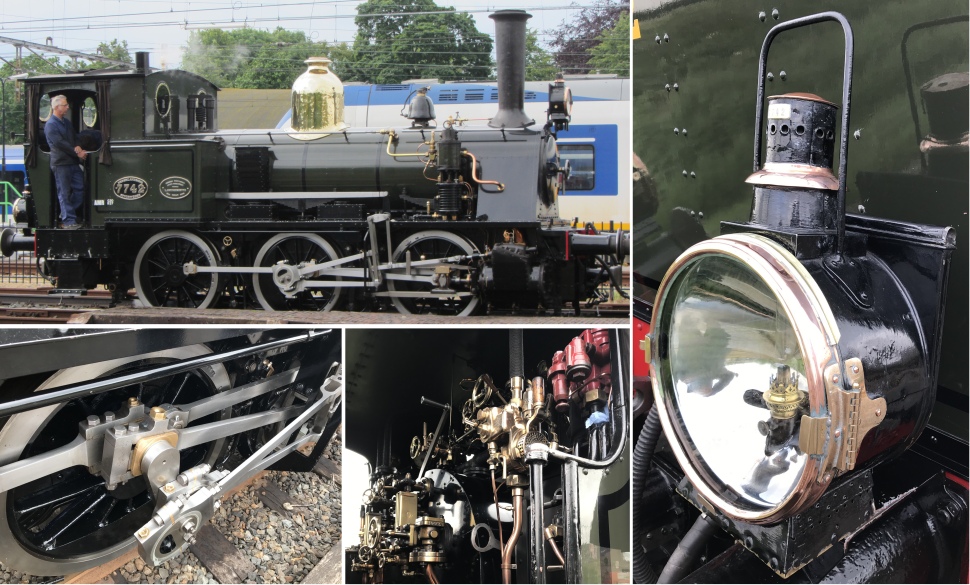 Bello |
 Characters in Costume on Bello |
Once on board the train, my mind was swept back to an earlier age by the sound of steam hissing out of the train whistle. The elderly train slowly trundled out of the station with the grind of metal wheel flanges against rail lines. Parents and grandparents stood waving with children as we crept through the suburbs of Hoorn. Gradually I sunk into the rhythm of the wheels.
The train line passed many elongated villages on its route, the most beautiful of these being the conservation village of Twisk with its historical "stolp" farmhouses (so named because of the shape of the roof resembles a bell-glass cover or "stolp"), and Opperdoes with its picturesque waterways.
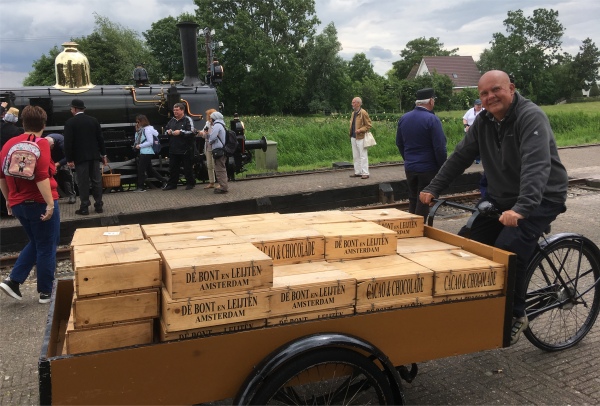 Delivering Supplies for Rex |
Medemblik was a prosperous trading town, when, in 1282, Floris V, Count of Holland, successfully invaded West Friesland. He built several fortresses to control the region, one of which was Kasteel Radboud in Medemblik, and awarded Medemblik city rights in 1289. After Floris V had been murdered in 1296, the local Frisian besieged the castle, but in 1297 an army from Holland thwarted their efforts to starve out the inhabitants, which included Medemblik citizens.
Several more attacks took place in the following centuries. The most notorious of these happened in June 1517, when Medemblik was attacked from mainland Frisia by about 4000 pirates known as the Arumer Zwarte Hoop, led by Pier Gerlofs Donia and Wijard Jelckama. Many citizens fled to the castle, which the pirates unsuccessfully besieged. Eventually, they took out their fury on the town, which burned to the ground. After this the band continued their marauding path on land throughout present day North Holland.
 Friesland |
Having cast our eyes over the town, we followed the sea wall around until we were forced back into town by one of several large marinas. A small Dragon boat was entering a marina from the Ijsselmeer, entirely under sail, and impressively made its way up to a pontoon in a basin. We learned that this week Medemblik was hosting a Dragon Race Cup regatta.
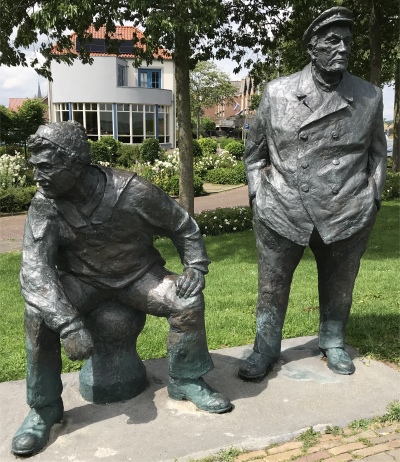 De Beste Stuurlui .... (The Best Mates ...) |
We visited the castle six years earlier, but sadly we did not have enough time for a revisit. Indeed we had to put our skates on in order to get back down the main street, Nieuwstraat, up to the Stadhuis which stood before the station. The Stadhuis was built in 1940 to a design by architect AJ Kropholler on the site of the old 17th-century town hall. The building consists of a monumental main building and a recessed side wing, which originally housed a fire brigade garage and two service residences. This wing was later also used for the benefit of the town hall. The town hall is an extension of the Nieuwstraat, so that the building acts as a closure of the main street in the direction of the Ijsselmeer. The elevated location reinforces the impressive impression. The high sloping gable roof with the massive stepped gable gives an even stronger accent to the monumentality intended by the architect. The high pavement (intended to hold speeches, among other things), which can be reached laterally with two opposite stairs, is also intended to give the building great allure. By using the high pavement, the stepped gable, the cross-frames, the placement of the carved municipal coat of arms, as well as in the choice of material, brick and natural stone, Kropholler emphasized the connection with the traditional Dutch form of town hall construction. In this respect the town hall of Medemblik connects with the town halls in Wateringen and Waalwijk built by Kropholler. The main building is made of red brick and has two floors.
 Radboud Castle |
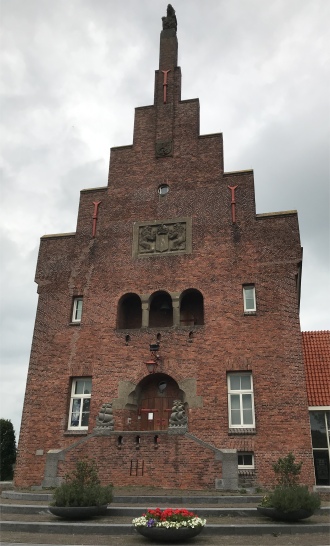 Stadhuis |
Back in Hoorn, I left Rex to search for cough medicine while I hand washed some clothes and dried them. Rex did manage to locate some medicine, so hopefully he would return to full health soon.
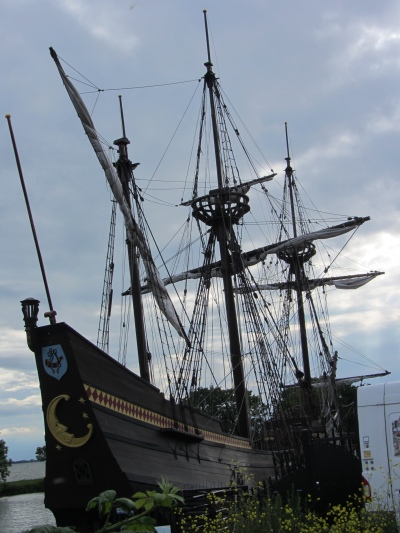 Halve Maen |
Not only did the original Halve Maen cross the Atlantic and explore the east coast of North America in 1609, but she would later sail to the other side of the globe, where she was destroyed by an English attack on Jakarta in the Dutch East Indies around 1618. The carracks of Portugal, England, Spain as well as the Dutch vlieboots, opened the world to European exploration. In Western terms, they were the ships of the great "Age of Discovery." On the other hand, they were also the plague ships that brought diseases which wiped out an estimated 90% of Native Americans.
In the evening I spotted a young Dutch lad busy at work on a boat whose navigation lights had been left on for quite a while. "Do you realise your navigation lights have been on for some time," I pointed out. "Yes, that is no problem, we are connected up to the mains supply," he slickly answered. He carried on, "Our problem is with the radio. I am now putting in a new cable up the mast," he said as he yanked another length of the old cable down the mast, "We intend to sail over to England soon," he continued. "From Ijmuiden?" I asked. "Yes, Ijmuiden to Shotley," he replied, "We used to sail to Lowestoft, but the women there are wild," he laughed. The old man on the boat, who I presumed to be his father, laughed too. "We will go from Shotley to Woodbridge, then Burnham-on-Crouch, then onto Ramsgate before heading across to France." The pair obviously had a lot more work to do, so we wished them luck, and headed into town.
